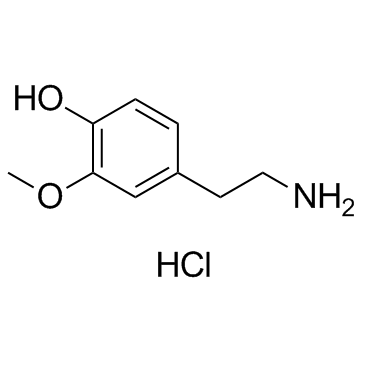3-Methoxytyramine hydrochloride (3-O-methyl Dopamine hydrochloride) (Synonyms: 3-Methoxy-4-hydroxyphenethylamine, 3-Methoxy-p-hydroxyphenethylamine, 3-O-methyl Dopamine) |
| Catalog No.GC33738 |
Le chlorhydrate de 3-méthoxytyramine (chlorhydrate de 3-O-méthyl dopamine) est un métabolite inactif de la dopamine qui peut activer le récepteur 1 associé aux traces d'amines (TAAR1).
Products are for research use only. Not for human use. We do not sell to patients.

Cas No.: 1477-68-5
Sample solution is provided at 25 µL, 10mM.
3-Methoxytyramine hydrochloride is an inactive metabolite of dopamine which can activate trace amine associated receptor 1 (TAAR1).
The intensity of the fluorescence developed is in a linear relation to the amount of 3-Methoxytyramine hydrochloride presented in the sample up to at least 1 μg. When a high concentration of dopamine is present in the reaction mixture, there is some reduction in the fluorescence derived from 3-Methoxytyramine hydrochloride[1].
The extracellular DA metabolite 3-Methoxytyramine hydrochloride (3-MT) induces significant behavioral activation in DDD mice. This activity however, is mostly presented as a set of disorganized abnormal movements that includes tremor, head bobbing, straub tail, grooming and abnormal orofacial movements rather than normal forward activity. No effect is observed when 3-Methoxytyramine hydrochloride is infused at doses below 9 µg, at 9 µg and higher doses 3-Methoxytyramine hydrochloride dose-dependently causes transient behavioral activation with a complex set of behaviors. In particular, transient hyperactivity and stereotypy, sniffing, grooming, rearing and mild abnormal involuntary movements (AIMs) at the level of limbs is observed after infusion of 9 µg of 3-Methoxytyramine hydrochloride. Similar behaviors are also observed after 18 µg of 3-Methoxytyramine hydrochloride with the additional appearance of tremor as well as oral and whole body AIMs[1].
[1]. Sotnikova TD, et al. The dopamine metabolite 3-methoxytyramine is a neuromodulator. PLoS One. 2010 Oct 18;5(10):e13452. [2]. Guldberg HC, et al. Some observations on the estimation of 3-methoxytyramine in brain tissue. Br J Pharmacol. 1971 Aug;42(4):505-11.
Average Rating: 5 (Based on Reviews and 26 reference(s) in Google Scholar.)
GLPBIO products are for RESEARCH USE ONLY. Please make sure your review or question is research based.
Required fields are marked with *




















